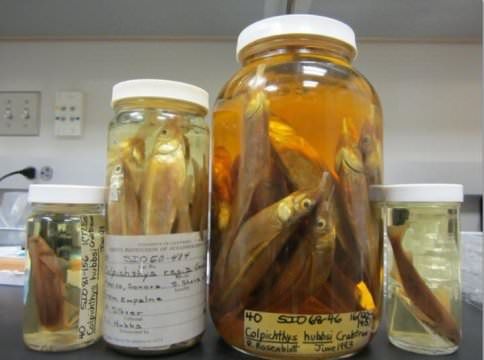Native Fish Species at Risk Following Water Removal from the Colorado River
Published on by Water Network Research, Official research team of The Water Network in Academic
Water extraction places ecologically distinct native species at risk of extinction through hybridization
Agriculture and domestic activities consume much of the Colorado River water that once flowed to the Colorado Delta and Northern Gulf of California.
The nature and extent of impact of this fresh-water loss on the ecology and fisheries of the Colorado Delta and Gulf of California is controversial. A recent publication in the journal PeerJ reveals a previously unseen risk to the unique local biodiversity of the tidal portion of the Delta.

Source: Jars of preserved fish specimens from the Scripps Institution of Oceanography used in this study. Credit: Clive Lau
Unique ecological species evolved in the historically fresher Colorado Delta and adapted to this environment. These fish are distinct from closely related species in the historically saltier estuaries found in other regions of the Gulf. However, the Colorado Delta is now more similar in salinity to many of the other estuary systems in the Gulf of California, suggesting that the ecological factors that separated species may have broken down.
Workers from UCLA examined species of silverside fish in a genus that only occurs in the Gulf of California. One species, Colpichthys hubbsi, lives exclusively in the Delta and is listed as endangered due to its restricted range. Morphologic and genetic anayses demonstrate that this species hybridizes along the western edge of the Delta with Colpichthys regis, a widespread relative distributed in estuaries throughout the Gulf.
Although hybrids could be recognized morphologically, there was no evidence of hybridization in earlier museum collections.
Furthermore, the genes from the widespread species were found to penetrate the range of the Delta specific species, but there were no genes from the Delta species found elsewhere in the Gulf. Thus, there was clear evidence of gene movement in one direction between the two species. This potentially places the Delta species at risk of extinction as its genome is swamped or replaced by the genes of the other species.
In this particular case, more work is needed to clarify the detailed causes of species separation and the nature of ongoing impacts to the genome of the Delta species. However, there are broader issues at stake than a single species. Other groups of fishes and crabs also appear to have evolved as ecological species restricted to the Colorado Delta.
These may also be at risk. More broadly, water extraction continues to accelerate in large river systems around the world. Thus, loss of ecological species in deltas and estuaries around the world is also likely accelerating.
Museums and institutions in Mexico, including the Los Angeles County Museum of Natural History, Scripps Institution of Oceanography CIAD in Guaymas facilitated this work by sharing their collections and supporting field work.
Source: Science Daily (Provided by PeerJ)
Journal Reference :
Clive L.F. Lau, David K. Jacobs. Introgression between ecologically distinct species following increased salinity in the Colorado Delta- Worldwide implications for impacted estuary diversity . PeerJ , 2017; 5: e4056 DOI: 10.7717/peerj.4056
Media
Taxonomy
- River Studies
- Ecosystem Management
- River Engineering
- Animal health